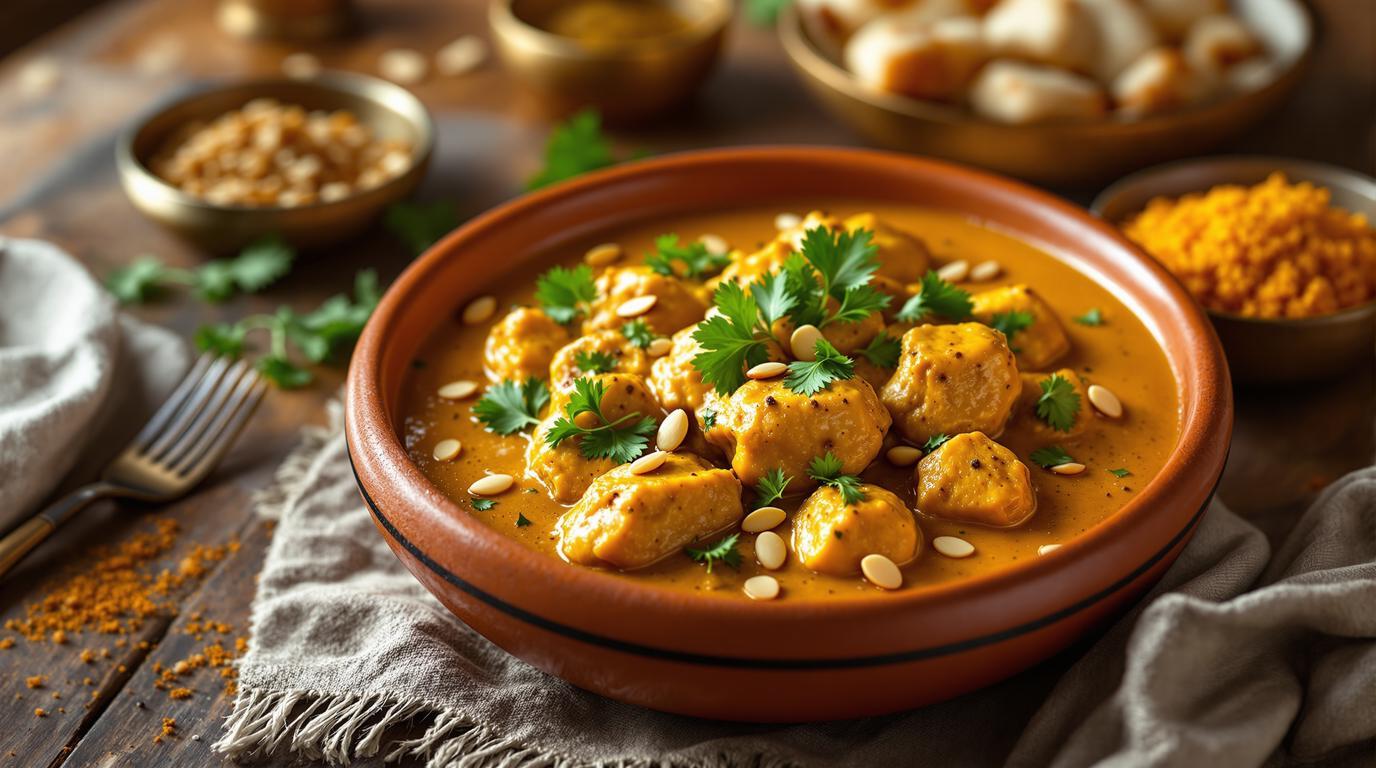I’ll never forget the first time I made korma in my culinary school days. Our instructor, Chef Patel, watched with a critical eye as twenty students frantically sautéed onions to the perfect golden-brown. “Too pale and your sauce has no soul; too dark and the bitterness will ruin everything,” he cautioned. That lesson stayed with me through kitchens across three continents. What fascinates me about korma is that this luxurious dish—now a staple on restaurant menus—began as court cuisine for Mughal emperors, where cooks would spend entire days creating the perfect balance of spices and creaminess.
The Story Behind Classic Chicken Korma 📖
Korma (from the Turkish word “kavurma” meaning “to braise”) represents the pinnacle of North Indian cooking techniques. Unlike many curries that rely on tomatoes or chilies for flavor, a proper korma draws its character from carefully toasted whole spices and the gentle richness of nuts and dairy. During my time cooking in Lucknow—often considered the korma capital of India—I learned that village grandmothers would judge a cook’s skill entirely on their korma technique. The oil must separate slightly at the end, creating what they poetically call the “crowning jewels” of the dish.
Essential Ingredients 🧾
The soul of korma lies in its balance of ingredients:
- 2 lbs (900g) bone-in chicken pieces (bones contribute tremendous flavor)
- 1 cup (240ml) full-fat yogurt (provides tenderness and tang)
- ⅓ cup (80g) cashews, soaked in hot water for 15 minutes
- 2 large onions, thinly sliced (these will be caramelized to golden perfection)
- 5 whole green cardamom pods, lightly crushed
- 3 whole cloves
- 1 cinnamon stick
- 4 tablespoons ghee, divided (clarified butter adds incomparable richness)
- 1 teaspoon garam masala
- ½ teaspoon turmeric
- 1 tablespoon ground coriander
- Salt to taste
Chef’s Note: The difference between a good korma and a remarkable one often comes down to your onions. Take your time—15 to 20 minutes—to properly caramelize them to a deep golden color without burning. This creates the foundational flavor that can’t be rushed.
Step-by-Step Instructions 📝
1. Marinate the chicken: Combine chicken with half the yogurt, ½ teaspoon turmeric, and a pinch of salt. Refrigerate for at least 30 minutes (2 hours is better).
2. Create your flavor base: In a heavy-bottomed pot, heat 3 tablespoons ghee over medium heat. Add thinly sliced onions with a pinch of salt and cook slowly, stirring occasionally, until they reach a rich amber color, about 15-20 minutes. Add the soaked cashews for the final 2 minutes.
3. Make the paste: Let the onion-cashew mixture cool slightly, then blend with the remaining yogurt until smooth. This creates your korma’s signature velvety texture.
4. Build the aromatics: In the same pot, heat the remaining ghee. Add cardamom, cloves, and cinnamon, allowing them to sizzle for 30 seconds until fragrant. The aroma should fill your kitchen with warmth.
5. Develop the flavors: Add marinated chicken and increase heat to medium-high. Cook for 5-7 minutes until the pieces begin to color slightly.
6. Create the sauce: Reduce heat to medium-low, add the onion-cashew paste, coriander powder, and ½ cup water. Stir gently, cover, and simmer for 25-30 minutes, stirring occasionally, until chicken is tender and small oil droplets appear on the surface.
7. Finish with finesse: Gently stir in garam masala off the heat. Taste and adjust salt if needed.
Chef’s Secret Techniques 🤫
True korma relies on the bhunao technique—a slow sautéing that concentrates flavors. Never rush this process. I’ve served this dish countless times at special occasions, and guests always comment on its depth of flavor. For extra authenticity, finish with a few drops of kewra water (screwpine essence) or rose water—the secret aromatic flourish that transports you straight to royal Indian dining halls.
If cashews aren’t available, blanched almonds make an excellent substitute. Just as my grandmother would often use whatever nuts were on hand, I’ve learned that adaptability is essential in home cooking.
Serving & Presentation Tips 🍽️
Serve korma in a wide, shallow bowl to showcase its golden richness. I like to garnish with a light sprinkle of slivered almonds and fresh cilantro—the vibrant green against the warm golden sauce creates a beautiful contrast. While traditionally paired with naan or fragrant basmati rice, I’ve discovered that well-prepared korma also pairs beautifully with simple steamed jasmine rice, which allows the complex sauce to take center stage.
For a complete experience, serve alongside a cooling cucumber raita and a simple kachumber salad. I’m often reminded of how a sip of strong chai between bites cleanses the palate, allowing you to appreciate the korma anew with each mouthful. This is comfort food elevated to an art form—a testament to generations of cooks who understood that patience and attention to detail transform simple ingredients into something extraordinary.
